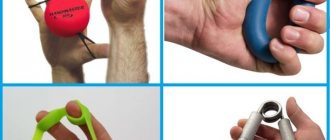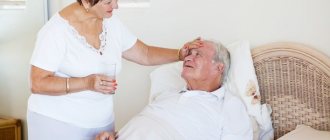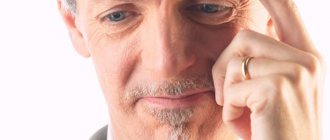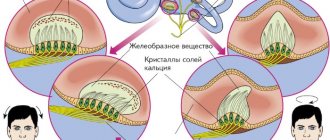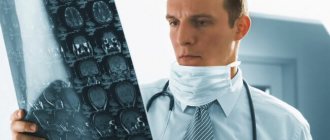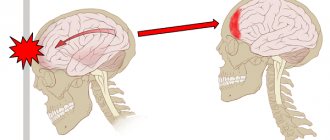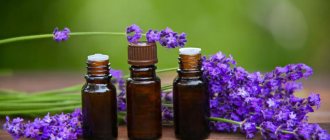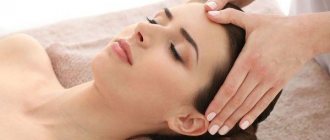Restoring the body at home
If you have suffered a mini-stroke, it will take time to fully recover. Treatment during this period is a complex of treatment and preventive measures, which include:
- drug therapy;
- dietary nutrition;
- physiotherapy;
- therapeutic exercises.
Treatment with medications consists of taking medications aimed at normalizing brain functions and eliminating the consequences of a micro-stroke, as well as, if necessary, treating the disease that caused its development.
Dietary nutrition is also an important component of successful therapy during the recovery period. Lack of important micro- and macroelements, abuse of junk food rich in cholesterol and trans fats worsens vascular patency, provoking the formation of thrombosis and cholesterol plaques.
Physiotherapeutic procedures and alternative treatments include:
- hirudotherapy (treatment with leeches);
- acupuncture;
- massage;
- electrophoresis;
- electrosleep;
- water treatment, climatotherapy.
Physical activity should be dosed, regular and in accordance with individual capabilities. A course of physical therapy can be taken with a doctor’s direction in a physical therapy room.
In addition, it is important for the patient to create a favorable, calm atmosphere, to protect him from unnecessary stress and neuroses. Excessive physical activity and fatigue are not allowed. In general, it is necessary to reconsider the overall lifestyle and eliminate the negative factors that led to the development of a micro-stroke.
Diet
Nutrition is of no small importance during the recovery period after a mini-stroke.
For therapeutic and preventive purposes, adherence to the following diet and principles of proper nutrition is prescribed:
- fractional meals in small portions;
- exclusion of fatty, smoked, fried, salty, canned foods;
- limiting salt intake to 2-5 grams. in a day;
- reducing caloric intake.
The therapeutic diet should include fruits and vegetables, cereals rich in magnesium, potassium and fiber. Also, the diet should contain foods containing unsaturated fatty acids (vegetable oils, sea fish, poultry), and limited fast carbohydrates (butter and confectionery products, potatoes, rice).
As for drinks, it is useful to drink natural juices, compotes, and jelly. It is better to replace strong tea and coffee with healing herbal infusions (sage, chamomile, mint).
You may be interested in an article about the treatment of cerebral atherosclerosis.
There is also an informative article about treating headaches at home.
Read here to learn how to normalize high blood pressure yourself.
Phytotherapy
Herbal medicine can be an effective and useful aid in treating the consequences of a mini-stroke. Healing plants normalize blood supply to the brain, reducing the manifestation of atherosclerosis.
For speech disorders after a micro-stroke, taking sage decoction is useful. To prepare it, 1-2 tbsp. sage leaves are poured with hot water and left for 1 hour. The resulting infusion is filtered and taken ½ glass per day. Duration of treatment – 1 month.
To normalize blood pressure, a mixture of herbs and medicinal plant roots is used: valerian root - 20 g; hawthorn - 20 g; yarrow - 30 g; calamus root and periwinkle herb 10 g each. Mix the ingredients, take 1 tbsp. and pour 0.5 liters of hot water. Place in a dark place overnight, then strain the infusion and drink 1 glass per day.
Shilajit has general strengthening properties. Dosage is calculated based on body weight:
- up to 70 kg – 0.2 g;
- 80 kg – 0.3 g;
- up to 90 kg – 0.3-0.4 g;
- over 90 kg – 0.4-0.5 g.
The product is diluted in liquid. The best option is milk (1:20) or water, you can add a little honey to the drink. Shilajit can also be diluted in grape or cucumber juice, in infusions of blueberries, cumin, and parsley. The course of treatment is 14 days, then a break of 7 days. Number of courses: 3-4.
Mode
The key to success in restoring health after a mini-stroke is the creation of favorable conditions, both at home and at work:
- compliance with the work and rest regime;
- full sleep.
Stress and chronic fatigue can be factors that reduce the effectiveness of treatment and provoke the risk of relapses and complications.
Physical activity should not be excessive, but regular. Daily physical exercise in the form of exercise will be useful during the recovery period. It is also recommended to be outdoors every day.
Alternative medicine methods
Traditional medicine recipes can only be used as concomitant methods of treating the disease.
Attention. A microstroke cannot be treated by taking certain herbal infusions and decoctions. These agents can only be used as an addition to the main treatment protocol.
However, recovery time after a mini-stroke can be shortened by supplementation in the form of infusions and decoctions. But before use, it is better to consult your doctor.
Horse chestnut tincture
The drug reduces swelling of brain tissue.
To prepare the tincture, pour 100 ml of alcohol into a container with 10 grams of crushed raw materials. You need to infuse the drink for 3 days in a dark place.
There is a pharmacy version, which is manufactured in production. This is probably a simpler option.
Use the tincture three times a day before meals. 30 - 40 drops before meals. It is recommended to take it for a month.
Pay careful attention to contraindications. It is not recommended for use by patients who have low blood viscosity, who suffer from low blood pressure (hypotension), pregnant women in the first trimester, and lactating women.
Particular attention is paid to diseases of the gastrointestinal tract - there is practically a ban on the use of tincture.
Hemlock tincture
You need to pour 10 grams of hemlock with 100 ml of vodka, infuse the liquid for 3 weeks. Then the tincture is filtered and consumed 2 times a day, half a teaspoon. The product increases vascular tone.
The pharmacy sells hemlock extract. You can use it.
However, we must understand that hemlock is a serious plant with a history and has its own specifics. Before using it, the liver should be prepared. The attending physician can best advise how to do this for a particular patient. Don't ignore your doctor. If your doctor is unable to say anything, look for someone more knowledgeable.
Mixed with honey
The product improves immune status, strengthening blood vessels.
You need to grind one lemon using a meat grinder, add natural honey, figs and 50 grams of alcohol to the pulp.
The product is infused throughout the day and taken a teaspoon after meals.
Sage decoction
The drink is effective for speech disorders, it reduces the effects of atherosclerosis.
Pour a tablespoon of dried raw material into a glass of boiling water and leave for 60 minutes.
The product should be strained and taken half a glass per day. To improve the taste, you can add honey.
Herbal collection
The infusion normalizes blood pressure.
You need to mix 20 grams of hawthorn, valerian, yarrow and pour half a liter of boiling water over the ingredients. The mixture should be placed in a dark place for 12 hours. Take 200 ml per day.
Treatment of microstroke at home
What medications do patients take after a ministroke after discharge from the neurology clinic? The medications that doctors prescribe for microstroke help stabilize the patient’s condition. After the inpatient treatment phase, they continue to take medications at home.
What medications are prescribed after a mini-stroke? To restore brain nutrition after a stroke, doctors at the Yusupov Hospital recommend that patients take angioprotectors and nootropic drugs. They affect neurons in the brain in different ways. Neurologists take this into account when prescribing them to a specific patient. So, for vagotonia, aminalon and piracetam are used, and for sympathicotonia, pantogam is used.
For a long time after a mini-stroke, patients take medications to improve brain function. These include cortexin. The composition of the drug includes peptides, vitamins, amino acids. Solcoseryl modulates brain activity. Patients after a microstroke take glycine tablets for 2-4 weeks.
To prevent a recurrent stroke, neurologists at the Yusupov Hospital prescribe warfarin. Aspirin reduces the likelihood of recurrent acute cerebrovascular accident. It has minimal side effects. If the patient does not tolerate drugs that contain aspirin, a combination of it with dipyridamole is used.
In order to prevent micro-stroke, doctors at the Yusupov Hospital also prescribe statins, antihypertensive drugs (in the presence of arterial hypertension), and herbal medicines that normalize lipid metabolism and lower blood pressure to patients.
Primary prevention of microstroke involves solving the following problems:
- make an adequate prognosis for the development of cardiac pathology;
- correct the negative impact of risk factors on the patient’s health;
- selection and prescription of necessary medications.
Patients at high risk of acute cerebrovascular accident should give up bad habits, lead a healthy lifestyle, eat right, and control blood pressure with medications.
Consequences of a micro-stroke suffered on the legs
We remind you that a transient ischemic attack requires hospitalization. It allows you to find out the reason why the attack occurred. If you do not seek help in time, the attack may recur. Some patients experience several attacks per day. And each of them can end fatally.
A microstroke suffered on the legs usually leads to ischemic-type ONCM, severe arrhythmia. In addition, TIA leads to decompensation of coronary heart disease.
Men
The stronger sex is more likely to experience micro-stroke. And this group has the highest number of refusals from hospitalization. This is why a transient attack is dangerous. The affected vessels are so small that they do not cause severe damage. Or the symptoms disappear altogether. This imaginary well-being usually leads to severe strokes. And the most common reason is the lack of timely medical care.
Remember about the risk group:
- Age over 60 years;
- Drinking alcohol;
- Smoking;
- Obesity;
- Diabetes;
- Arterial hypertension;
- Systemic atherosclerosis.
Microstroke in diabetes mellitus (DM)
It is known that blood vessels are additionally affected in this disease. Their walls become thinner, and atherosclerosis progresses. An additional risk factor is increased diuresis in diabetes. This creates additional conditions for blood thickening. Therefore, strokes with diabetes occur 2.5 times more often.
In an elderly patient with this disease, the risk of having a stroke after a TIA increases several times. And the main role in this is played by collateral circulation. When a blood clot closes a major vessel, blood rushes around the blockage. At the same time, diabetes turns small capillaries into hard “glass” tubes that are not able to compensate for such blood flow. Ischemia intensifies.
Women
Micro-stroke “on your feet” is experienced by 30-40% of the population in developed countries. In Russia there are no adequate statistics. However, these numbers will be higher. What follows an ischemic attack in a woman?
Firstly, any brain hypoxia leads to unusual fatigue, depression and headaches. If the patient has not experienced them before, this is a reason for examination. Secondly, after a TIA, performance and cognitive functions are significantly reduced. This affects the quality of work, especially if a woman holds a leadership position.
Consequences of an attack depending on its location
So, any attack occurs as an ischemic type of stroke. There are two types of TIA based on the location of the lesion:
- Vertebro-basilar basin;
- Carotid basin.
So, the first option occurs in 70% of cases. What symptoms accompany the event?
- Dizziness with occipital pain;
- Nystagmus;
- Diplopia (double vision);
- Nausea and vomiting;
- Loss of half the visual field (usually bilateral);
- Flashing “flies” before the eyes;
- Damage to the muscles of the face, pharynx, tongue, soft palate;
- Sudden fall without loss of consciousness;
- Short-term loss of memory and orientation.
TIA in the carotid region behaves like this:
- Loss of sensation in one or more limbs;
- There is no movement in one or more limbs;
- Speech is partially or completely lost;
- Vision disappears in one eye, paralysis of half the body develops on the other side.
Ischemic stroke
TIA lesions resolve within 10 minutes to 1 hour. If the symptoms do not go away within a day, a diagnosis of acute cerebrovascular accident is made. And this is a completely different disease. It has a high mortality rate and a long rehabilitation period.
How to treat ischemic stroke?
- Correction of blood pressure at numbers above 200/110 mmHg. You cannot reduce the pressure at lower numbers, otherwise the blood supply to the brain will stop altogether. You should also not use medications that give a quick effect (nifidipine). Preference should be given to captopril, enalapril;
- Fighting cerebral edema (mannitol);
- Diazepam is administered to relieve seizures.
When treated in a hospital, the patient is given neuroprotective therapy. These are glycine, emoxypine, cytoflavin, cerebrolysin.
Prices for ministroke treatment
| Name of service | Price |
| Consultation with a neurologist | Price from 3600 rubles |
| Therapeutic massage of 1 anatomical area (up to 15 minutes) | Price: 2000 rubles |
| Lymphatic drainage manual massage (up to 45 minutes) | Price: 5000 rubles |
| Correctional session with a speech therapist-defectologist | Price: 3100 rubles |
| Individual kinesiotherapy session 30 minutes | Price: 2500 rubles |
| Comprehensive rehabilitation program after stroke | Price from 10,830 rubles per day |
Download price list for services
We work around the clock
Sign up for a consultation by phone or send a request through the form
Symptoms and consequences
The specificity is that lesions are created in the brain for a long time and gradually destroy neural connections. Symptoms may go away on their own within a couple of days.
Important! Frequent cases of microstroke lead to the development of stroke. . The following symptoms are identified:
The following symptoms are identified:
- sudden severe headaches, dizziness;
- discomfort that occurs in the epigastric region, pharynx and oral cavity, which often ends with vomiting;
- numbness of the limbs;
- formication;
- deterioration of vision: loss of sharpness, dots of different colors float before the eyes;
- speech impairment, the tongue becomes as if mute;
- loss of coordination;
- weakness and rapid fatigue;
- high blood pressure;
- poor reaction to light, pain in the head from sudden noise and unpleasant odors;
- Possible loss of consciousness for some time.
We also advise you to read the article: "".
Who is most susceptible to the disease?
According to statistics, microstroke is most often diagnosed in people 65 years of age and older.
This fact is explained by age-related changes that occur in the structure of blood vessels, as well as pathologies that disrupt the blood circulation process. However, every fourth attack occurs in a young person. This is due to circumstances such as poor diet, addictions, physical and emotional overload. What categories of people are at risk? Those who are more likely to develop the disease include:
- People suffering from hypertension.
- Patients with atherosclerosis of spinal vessels.
- People who use tobacco products.
- Diabetics.
- Persons with myocardial disorders (arrhythmia, ischemic heart disease, endocarditis).
- People with increased blood clotting.
- Women using contraceptives that contain hormones.
- Patients with cervical osteochondrosis.
- Persons who are overweight.
Since in recent years the pathology has often been diagnosed in young people, the question of what to do in case of a microstroke at home is relevant not only for elderly patients.
First aid and basic therapy
If a person managed to move on his feet, this does not mean that he does not need outside help. Although the symptoms of the disease pass fairly quickly, they significantly worsen overall health. Not everyone's symptoms go away within a few minutes; in some people they may persist for 24 hours.
You should adhere to the following advice from doctors:
It is important to provide a person with peace. It should be placed on a flat surface, with the head higher than the limbs. Open window
The patient must breathe freely, so you should ask all the people around you to leave. This will increase the flow of fresh air to the patient. If necessary, you should unbutton the top buttons on your shirt, or cut clothes that are too tight. This is necessary to make it easier to breathe deeply. A sick person should not be allowed to move, even if he feels better. After all, such changes can be temporary and deceptive.
There is no need to give the person any medications, especially antispasmodics. They can worsen the patient’s condition, so you should not use medications until the ambulance arrives.
Self-medication always leads to negative consequences, so it is important to immediately consult a doctor
After examining the patient, the doctor may prescribe a number of medications. Among them are vasodilators, drugs to improve blood microcirculation, and nootropics. Medications that prevent the formation of blood clots are also prescribed. Additionally, the doctor can refer you for a massage, classes with a speech therapist, and also prescribe therapeutic exercises. In the future, it is worth eliminating those factors that provoked a mini-stroke. Such measures will help avoid negative consequences.
Recovery after a mini-stroke at home
If a microstroke occurs for the first time in a patient, then with proper rehabilitation it is possible to completely restore the functions of dead brain cells. Treatment after a mini-stroke at home can last a different amount of time. It all depends on how extensive the lesion was. With a micro-stroke, they are much smaller than with a stroke, so recovery often takes several weeks, less often - several months. Rehabilitation is carried out comprehensively. It includes the following areas of therapeutic intervention:
- Drug treatment. It is necessary to restore normal blood supply to the brain, reduce blood pressure, and prevent the formation of blood clots that can clog blood vessels and lead to a recurrence of a micro-stroke.
- Improving motor functions. It is provided through physical therapy (physical therapy), massage, and physiotherapy.
- Restoring vision. If the patient is completely blind, surgical treatment may be prescribed. In case of deterioration of vision, the patient should perform a set of exercises to improve oculomotor functions.
- Restoration of speech function. It is carried out in two directions: understanding spoken and audible speech, writing and reading. To restore speech, perform articulation exercises. Some patients require sessions with a speech therapist.
- Normalization of psychological state. A microstroke rarely causes mental disorders in a person. If complications still interfere with usual activities, then the patient may need the help of a psychotherapist or psychologist. Specialists will help you set yourself up for successful treatment.
What medications are prescribed
Drug therapy includes the following drugs for microstroke:
- Anticoagulants (Warfarin). The drug inhibits the activity of blood clotting factors. Treatment begins with the administration of minimal effective doses. If there is no result, the amount of administered substance is gradually increased until the prothrombin time increases. In case of hemorrhagic stroke, anticoagulants are contraindicated. When treating pregnant women, Warfarin is replaced with Heparin.
- Antiplatelet agents (Aspirin). The drugs eliminate pathological blood viscosity, dissolve blood clots and dilate blood vessels. Aspirin has minimal side effects. If you are intolerant to acetylsalicylic acid, use Dipyridamole. If microstroke occurs multiple times, Ticlopidine is prescribed.
- Drugs that reduce the load on nerve cells (Cerestat). Medicines normalize blood circulation and prevent damage to brain tissue.
- Thrombolytics (Alteplase). Medicines quickly dissolve blood clots, restoring blood supply to the brain. They must be administered in the first 6-12 hours after an attack. Drugs of this pharmacological group are contraindicated for hemorrhagic stroke.
Important information: Where to place leeches after a stroke (hirudotherapy)
Nootropics
Patients who have suffered a mini-stroke need to take medications that normalize metabolism and blood circulation in the brain. Nootropic medications for microstroke have the following effects:
- increase the amount of glucose penetrating the blood-brain barrier;
- normalize the production of nucleic acids in nerve cells;
- stimulate the synthesis of phospholipids;
- restore the activity of the central nervous system;
- prevent excessive increase in neuronal activity;
- reduce the need of nerve cells for oxygen, allowing the brain to function normally under hypoxic conditions.
For a microstroke the following is prescribed:
- Nootropil. The drug improves memory and restores the innervation of muscle fibers. The course of treatment with this drug lasts at least 3 months.
- Encephabol. Contains pyridoxine, which has a pronounced anti-ischemic effect. The medicine is used in the subacute period of the disease. The therapeutic course lasts 1.5-3 months.
Medicines to normalize blood pressure
A microstroke in most cases is accompanied by a sharp rise in pressure. Taking antihypertensive drugs (Cordipine, Nifedipine) helps prevent the occurrence of dangerous consequences of an attack. These drugs are used from the first day of illness until blood pressure normalizes. Antihypertensive drugs have the following properties:
- remove excess fluid, preventing an increase in blood and intracranial pressure;
- protect blood vessels and heart muscle from damage;
- eliminate headaches caused by cerebral edema.
Start taking pills by administering minimal doses. If well tolerated, the dose is gradually increased to maintenance.
Main principles of rehabilitation treatment
In order for the efforts made to bring the expected effect, rehabilitation must be based on several principles:
- Timeliness. Rehabilitation should begin in the neurological department and continue at home.
- If a rehabilitation therapist is working on recovery, patients and caregivers must be actively involved in the process. Frequent repetition of tasks will significantly speed up recovery.
- Consistency and systematicity - at the beginning of the recovery period, simple and gentle methods are selected. Over time they become more complex. Interruptions in treatment are not allowed.
- Individuality – a set of rehabilitation measures carried out at home is selected according to the requirements of each patient.
Full rehabilitation is possible only with the comprehensive application of the following areas:
- taking medications;
- restoration of motor functions;
- resumption of speech;
- psychological rehabilitation;
- social adaptation.
Taking medications
Microstroke is a serious risk factor for the development of ischemic strokes. They are much more difficult. In addition, strokes are characterized by persistent residual effects (for example, paralysis of the limbs on one side of the body), which significantly worsen the life of the patient and his loved ones. Therefore, drug treatment is aimed not only at restoring lost brain functions, but also at preventing repeated episodes of the disease.
Preventive actions
If you do not want to face a micro-stroke in the future, you need to adhere to a number of preventive rules throughout your life:
- Monitor your blood pressure. The ideal option is a diary in which you will note daytime and evening blood pressure readings.
- You need to adhere to a salt-free diet. Eat as many fresh vegetables, fruits, boiled fish and legumes as possible.
- It is necessary to get rid of bad habits, namely, smoking and the habit of drinking strong drinks.
- It is also worth adhering to a work and rest schedule.
- Do not expose yourself to stressful situations.
- Exercise regularly or at least do morning exercises.
- It is necessary, whenever possible, to give up coffee, black tea and other tonic drinks. Preference should be given to herbal tea, natural juices and other vitamin drinks.
- Do not abuse synthetic drugs.
- You should try to spend more free time outdoors.
- Do not chase material values, exhausting your body and soul with backbreaking work.
- Work should bring moral satisfaction. Find something you like and do it with pleasure.
- If your profession can lead to a micro-stroke at 35–40 years old, change it immediately, otherwise the consequences will be disastrous.
- Don't forget to monitor your blood cholesterol levels.
Do not forget that a microstroke is a very dangerous disease, the treatment and prevention of which must be taken very seriously. If the disease is not treated after the first symptoms appear, the body will be susceptible to various serious complications.
A micro-stroke will not cause significant harm to the body, but it is an eloquent harbinger that there are certain problems and difficulties in the body that should be paid immediate attention. .
The first signs of a microstroke
Above, we tried to figure out who can be “overtaken” by a microstroke and what it is. Now let's talk about how to identify a microstroke by its primary symptoms. It is not difficult to suspect a minor ischemic stroke in yourself or someone nearby, knowing what symptoms are characteristic of it:
- The patient complains of dizziness and increasing severe headache;
- Vision deterioration often occurs: flashes and “spots” appear before the eyes;
- Coordination of movements is impaired: a person may stagger and even fall;
- Part of the face or limb goes numb;
- Blood pressure changes, vomiting is possible;
- Bright light and noise cause irritability and worsen headaches;
- The ability to speak deteriorates: it is difficult for a person to answer basic questions, speech becomes inarticulate.
Be sure to call an ambulance!
It is important to note here that even if the signs of the disease completely subsided after a few minutes, the state of health became normal, an ambulance should still be called. Timely detection of an attack significantly increases the chances of complete recovery
An ischemic attack of the brain may recur soon and possibly in a more serious form. Statistics say that a third of people experience the symptoms of a mini-stroke again. Every tenth person after a “minor hemorrhage” experiences a major stroke within three months. Moreover, 50% of attacks occur within the first 48 hours.
A microstroke and its symptoms are the first signs of an approaching major stroke.
Specificity of signs: why is a microstroke dangerous?
Many patients attribute the first symptoms of a micro-stroke (dizziness, headache of any intensity, general weakness) to constant fatigue and stress, weather changes and magnetic storms. Often, some symptoms of an attack are absent or mild, however, 4-5 signs are enough to make a diagnosis.
Why is a microstroke dangerous?
According to world statistics, the incidence of microstroke is 50-100 people per 100 thousand population. In Russia, in a regional city, the number of registered pathologies is approaching 25-27 per 100 thousand. It is worth assuming that the real figure is much higher. What are the dangers of ignoring TIA symptoms?
Long-term consequences of the disease are expressed in changes in well-being and deterioration in the quality of life. After the attack, sleep may be disturbed, unexplained headaches and dizziness may appear. A microstroke is not characterized by paralysis and paresis. But the muscles in the limbs become sluggish and difficult to obey. TIA is fraught with a complicated course of somatic pathology (arterial hypertension, diabetes mellitus).
Serious consequences of the disease:
- Risk of recurrent stroke in the first 48 hours;
- The dangerous situation may continue for another 3 months;
- After an attack, heart attacks, severe arrhythmias, and thromboembolic diseases may develop.
Can a stroke go unnoticed?
Unfortunately, there remains a high probability of a “silent” stroke. At the same time, elderly patients noted symptoms similar to TIA suffered in the past in 50% of cases. In addition, random MRI scans reveal focal brain lesions without a history in 10% of cases.
What symptoms are typical for “silent” strokes?
- Loss of vision in one eye (lasting less than 5 minutes);
- Short-term paralysis of the muscles of the face or limbs;
- Memory lapses, amnesia;
- Speech impairment for no more than 30 minutes.
As you can see, the symptoms are short-lived
In addition, the clinical picture does not lead to a serious decrease in function, so patients may not pay attention to it. However, specialists should not ignore such short-term symptoms
Hospitalization and further examination are required.
Microstroke on MRI
First, a brain scan is performed. Transient attacks lasting less than 60 minutes are not noticeable on MRI. Short-term disruptions in blood supply do not lead to cell death. This means that the tomogram will remain unchanged.
But if the TIA lasts up to a day, small infarcts can be detected in the medulla. As a rule, they are located in the basin of the artery in which the changes occurred. MRI with contrast enhancement of blood vessels makes it possible to establish a more accurate diagnosis and prevent the consequences of a stroke.
Changes in vital functions
Can a microstroke shorten your life? Of course, doctors note the negative impact of TIA on these periods. There are many factors on which the prognosis depends:
- Patient age (risk group – persons over 50 years old);
- High cholesterol;
- Arterial hypertension (with numbers above 140/90);
- Poorly controlled diabetes mellitus.
The risk of recurrent stroke is especially high with the following TIA:
- With cephalgia;
- With migraine and aura;
- Lasting more than one hour;
- With paralysis or paresis of the upper limb.
How long do they live after a mini-stroke?
Life expectancy after TIA is the wrong criterion. The possibility of subsequent events (major stroke, thromboembolic changes) should be assessed. Doctors can influence these threats by prescribing medication, and the patient himself must change his lifestyle. In this case, the prognosis will be favorable.
But after an acute cerebrovascular accident (ACVA), the patient’s life is shortened. Out of 100 people, about 40 die in the first month after stroke. More than half become disabled. After a year, 30% of patients who have suffered a stroke die, 25% are disabled. And only 45% return to normal life.
What can or cannot be done after a mini-stroke?
A transient ischemic attack is a red flag. Our body signals that there is a problem. And it can end fatally. What should you not do after a mini-stroke?
- Thinking that “if it’s passed, then it’s not serious”;
- Stay at home during an attack;
- Refuse hospitalization after examination by a doctor;
- Ignore chronic diseases;
- Continue to live with bad habits, obesity;
- Start daily exercise without consulting a doctor;
- Refuse drug therapy.
What should you do immediately after a TIA?
- Get examined in a specialized department;
- Visit specialists in chronic somatic diseases (cardiologist, endocrinologist) to adjust treatment;
- To refuse from bad habits;
- Increase physical activity;
- Lose weight;
- Review your diet;
- Reduce stress levels.
Symptoms of a microstroke
If we talk about the first signs and symptoms of a micro-stroke, they come quite abruptly, the acute phase develops within a couple of hours. The patient faces :
- numbness of the limbs
- paralysis and loss of sensation
- headaches, loss of consciousness and migraines
- problems with speech and memory
- irritability from loud music, lights
- sudden changes in body temperature
- weakness, severe fatigue, desire to sleep
Symptoms often develop against the background of stress, a sharp rise in blood pressure, or physical activity. Therefore, you need to call a doctor and start treatment immediately, since the formation of foci of inflammation will continue, destroying neurons and the nervous system, leading to repeated attacks.
It is also noteworthy that women may suffer from specific symptoms such as mood swings, migraines, irritability or fatigue. This happens due to the special physiological structure and hormonal levels.
What is a microstroke
With a micro-stroke, cerebral circulation is disrupted due to thrombosis or ischemia, resulting in tissue necrosis. The nutrition and function of brain cells are disrupted.
Recovery is possible if the blood supply to the affected area is normalized within 6 hours. During an attack, small vessels of the brain are damaged, which preserves the chances of effective treatment and complete rehabilitation in the future.
Manifestations of microinsult may not be clear and pass quickly. Therefore, a person cannot always adequately assess the degree of risk of health changes.
There is no official diagnosis of “ministroke” in medicine. This term is used to generally define changes in cerebral circulation.
A microstroke is a harbinger of a possible stroke in the future. Therefore, you should not neglect treatment, and also provide yourself with more favorable living conditions.
We recommend reading: Cardiac Arrhythmia
Differences from stroke
Firstly, during a massive hemorrhage in the brain, a large blood clot forms and the body is not able to cope with it quickly. The blood clot disappears only after a few hours or days. During this period, brain cells and tissues rapidly die due to nutritional deficiency and oxygen starvation. They will never be able to recover, so the patient’s severe consequences remain for life.
Secondly, the symptoms of a microstroke are less pronounced, and doctors mistakenly diagnose many patients with “vegetative-vascular dystonia,” attributing the ailment to a violation of cerebral vascular tone. A minor stroke is a serious signal that the blood supply to the brain has failed and the risk of a severe stroke is high. It should be remembered that a repeated micro-stroke can cause the same tragic consequences as a major one.
Types of stroke
Stroke is a disease in which blood flow to the brain is disrupted. Both partial and absolute cessation of blood flow in the brain is possible.
Doctors say that if you provide medical assistance to the patient in the first 3 hours, then terrible consequences can be avoided.
This disease ranks second in mortality. Disappointing statistics say that 80% of people who have had a stroke remain disabled.
Depending on the causes and nature of the course, there are two main types of stroke: ischemic and hemorrhagic. Let's talk about each in more detail.
Ischemic
Doctors identify the following causes of ischemic stroke: high blood pressure, pathologies of the blood, kidneys, blood vessels, atherosclerosis, migraine, heart rhythm disturbances.
Hemorrhagic
With a hemorrhagic stroke, damage to the vessel occurs, including its rupture. As a result of a ruptured vessel, a hemorrhage occurs in the brain and a cavity filled with blood is formed.
First aid for microstroke at home
What to do in case of a micro-stroke at home? If the patient has the first signs of cerebrovascular accident, he must be placed in bed, his head raised and turned to the side. You should unzip the window to open the window and provide access to fresh air.
After vomiting, you need to clear your mouth of any remaining vomit. Before the ambulance arrives, your blood pressure should be measured. If it is high, you can give the patient a drug that the patient usually takes to treat hypertension.
The person should be supported morally and convinced of the need for hospitalization. When patients are admitted to the Yusupov Hospital within 3-4 hours from the onset of the disease, the chances of full recovery increase many times over. At the neurology clinic, doctors use innovative neuroimaging methods (computer and magnetic resonance imaging), perform Doppler ultrasound, and radiography of the cervical spine. For laboratory research, high-quality reagents are used. Patients are consulted by a cardiologist, ophthalmologist and endocrinologist.
After this, doctors prescribe medications to restore blood flow through the cerebral vessels and protect brain cells from damage. In the presence of arterial hypertension, cardiologists individually select medications to control blood pressure and avoid hypertensive crises. The endocrinologist prescribes medications necessary to normalize blood glucose levels. If indicated, patients are consulted by a vascular surgeon to decide on the need for minimally invasive surgical intervention.
Patients are advised to avoid stress and fatigue. They should quit smoking and stop drinking alcohol. Sometimes you can drink a glass of dry red wine. The condition of blood vessels improves after dosed physical activity. The Yusupov Hospital has mechanical and robotic simulators that allow you to monitor heart performance directly during exercise.
If you have the first symptoms of a microstroke, call. Doctors at the Yusupov Hospital treat and prevent cerebrovascular accidents with the most effective drugs. Rehabilitators use innovative methods to restore impaired functions. You can take advantage of a comprehensive stroke rehabilitation program and undergo all the necessary procedures while saving money.
First aid
If you diagnose a micro-stroke in time and take the right actions in the first minutes and hours, you will be able to reduce the consequences and achieve success in recovery after it. First aid for a microstroke consists of the following:
- Call an ambulance and place the patient on his back, preferably with his head slightly elevated.
- Ensure you can breathe freely by loosening tight clothing if necessary and opening windows.
- Give me some water.
- You can apply a cold compress or ice to the back of your head.
- If there is vomiting or intense salivation, turn your head to the side and monitor the removal of secretions so that the person does not suffocate.
- If necessary, perform resuscitation measures.
- If there is a sharp increase in blood pressure, you need to give an antihypertensive drug or immerse your feet in a basin of hot water.
If you have any suspicions, you must call an ambulance; treating a microstroke, even with a slight severity, at home is unacceptable.
Prices for ministroke treatment
| Name of service | Price |
| Consultation with a neurologist | Price from 3600 rubles |
| Therapeutic massage of 1 anatomical area (up to 15 minutes) | Price: 2000 rubles |
| Lymphatic drainage manual massage (up to 45 minutes) | Price: 5000 rubles |
| Correctional session with a speech therapist-defectologist | Price: 3100 rubles |
| Individual kinesiotherapy session 30 minutes | Price: 2500 rubles |
| Comprehensive rehabilitation program after stroke | Price from 10,830 rubles per day |
Download price list for services
We work around the clock
Sign up for a consultation by phone or send a request through the form
